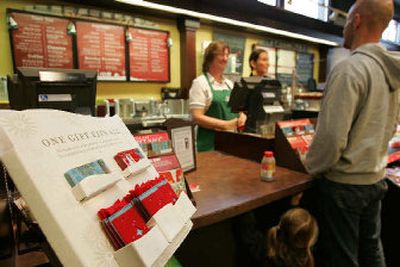It’s a clean swipe

SEATTLE — If there are eight people in line at a typical Starbucks, chances are one of them paid up before even setting foot in the store.
In the five years since the Seattle-based coffee retailer launched its Starbucks Card, it’s become a fixture in the wallets of millions of loyal customers. It’s also emerged as one of the company’s most heavily promoted and hottest-selling holiday gift items.
Most major retailers have been offering gift and loyalty cards for years, but industry observers say few have seen so many of their customers hang on to them as long, use them as often and reload them as regularly as they do at Starbucks.
“It’s unique in the sense that most retailers aren’t the kind where you have that everyday purchase,” said Scott Krugman, spokesman for the National Retail Federation, a trade group based in Washington, D.C.
During last year’s holiday shopping season, customers activated a record 15 million cards that raked in nearly $170 million once they were redeemed, accounting for 12 percent of the company’s North American revenue stream that quarter.
“The card has exceeded our expectations, absolutely,” said Sandra Stark, Starbucks’ director of marketing program management. “We knew it would be a great program. We had no idea that we would reach 12 percent of tender.”
Almost one in eight customers pays with a Starbucks card these days, Stark noted. About 96 million Starbucks cards have been activated in the United States and Canada since November 2001, and customers have reloaded their cards about 38.6 million times, bringing in $2.17 billion in revenue.
In early November, Starbucks started offering its card in the United Kingdom, selling so many it had to order more than double the number in the initial batch to keep up with demand. The card is also available in Japan, Spain, Germany, Greece, Australia and Thailand.
Starbucks plans to expand to other countries but isn’t saying where or when. It declined to release figures for international card sales, but spokeswoman Lisa Passe said the company is pleased with how customers are receiving the card in overseas markets.
Some fast-food restaurants have jumped into the fray recently.
Wendy’s International Inc. started promoting its new gift card around Thanksgiving. “Cards have become so commonplace in the retail sector that you really need to have one to be able to compete effectively,” spokesman Bob Bertini said.
McDonald’s and Burger King began offering customers reloadable convenience cards about a year ago. Both say they’re pleased with the results they’ve seen so far but would not share any sales figures.
Starbucks has been promoting its card in display cases near counters, offering buyers free rhinestone-studded stocking-like holders. Stark wouldn’t offer any hints about how card sales have been going in the early days of the holiday shopping season, but said the company has high expectations.
So do many other retailers. The National Retail Federation predicts that gift card sales in the United States will total $24.8 billion this holiday season — about $6 billion more than last year, based on a survey conducted by market research firm BIGresearch.
Gift cards used to be frowned upon as the last-ditch choice of only those who couldn’t be bothered putting any thought into the presents they got their loved ones. But in recent years, they’ve become more popular as gift givers and recipients alike have embraced the notion that it can be nice to give people the option of picking out their own presents.
“It’s just such a home run not to have to pick out something for someone, which they’re going to end up returning in 40 percent of the cases,” said Howard Davidowitz, chairman of Davidowitz & Associates, Inc., a national retail consulting and investment banking firm in New York.
Whether they receive them as gifts or use them like debit cards, customers say the Starbucks cards offer a quick, convenient way to pay for their caffeine fix.
“It’s a lot easier to use the card when you don’t have cash and you feel like an idiot putting $2 on your credit card,” Erik Carels, 34, said one recent morning after using his Starbucks card in Seattle.
Companies can’t claim the money loaded onto their cards as revenue until a customer redeems it toward an actual purchase. They can, however, earn interest on unredeemed card balances, though Starbucks wouldn’t disclose how much.
Registered Starbucks card holders, who number about 2 million, can reload their balances at the cash register, online or sign up to have their banks automatically reload their cards whenever they dip below a certain balance.
Jeff Phillips, a salesman who’s used his Starbucks card regularly for years, wonders why the company doesn’t offer card holders more perks, like a free latte for every 10 purchased.
“These guys are so successful they probably don’t feel like they want to give things away, but I always think there are ways to drive loyalty to be even stronger,” said Phillips, 35. “A lot of companies fall very short on that.”